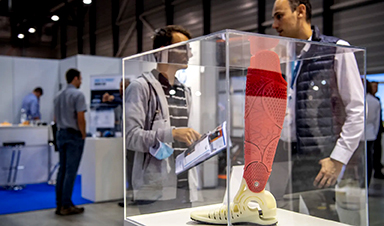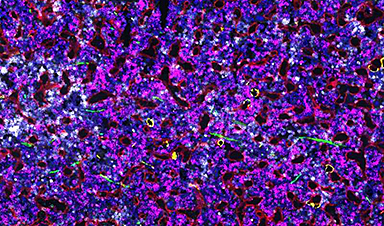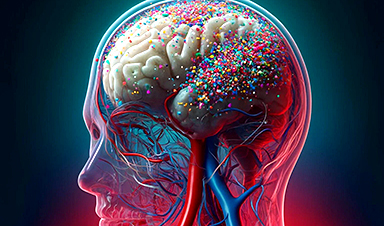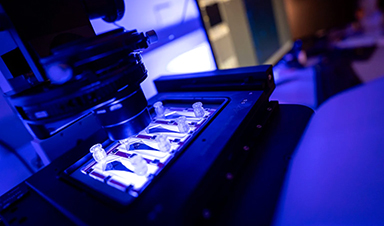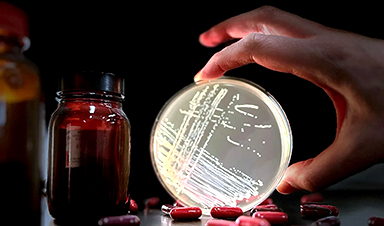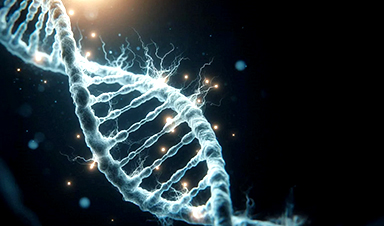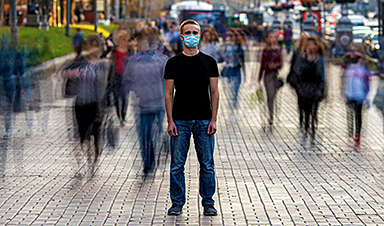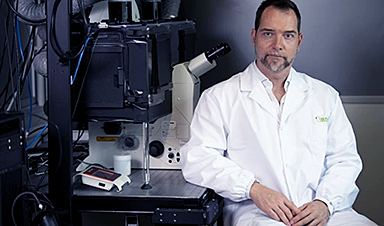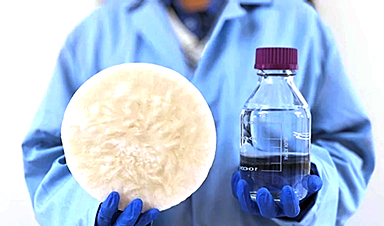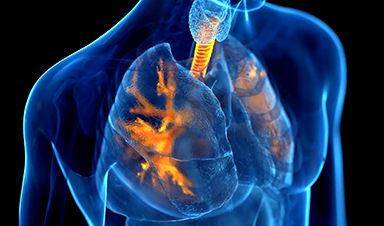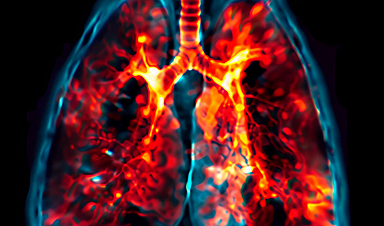Daegu Gyeongbuk Institute of Science & Technology (DGIST, President Yang Kook) Professor Hongsoo Choi’s team of the Department of Robotics and Mechatronics Engineering collaborated with Professor Sung-Won Kim’s team at Seoul St. Mary’s Hospital, Catholic University of Korea, and Professor Bradley J. Nelson’s team at ETH Zurich to develop a technology that produces more than 100 microrobots per minute that can be disintegrated in the body (Small, “A biodegradable magnetic microrobot based on gelatin methacrylate for precise delivery of stem cells with mass production capability”).
| Microrobots aiming at minimal invasive targeted precision therapy can be manufactured in various ways. Among them, ultra-fine 3D printing technology called two-photon polymerization method, a method that triggers polymerization by intersecting two lasers in synthetic resin, is the most used. This technology can produce a structure with nanometer-level precision. | |
| However, a disadvantage exists in that producing one microrobot is time consuming because voxels, the pixels realized by 3D printing, must be cured successively. In addition, the magnetic nanoparticles contained in the robot can block the light path during the two-photon polymerization process. This process result may not be uniform when using magnetic nanoparticles with high concentration. | |
| To overcome the limitations of the existing microrobot manufacturing method, DGIST Professor Hongsoo Choi’s research team developed a method to create microrobots at a high speed of 100 per minute by flowing a mixture of magnetic nanoparticles and gelatin methacrylate, which is biodegradable and can be cured by light, into the microfluidic chip. This is more than 10,000 times faster than using the existing two-photon polymerization method to manufacture microrobots. | |
| Then, the microrobot produced with this technology was cultured with human nasal turbinated stem cells collected from human nose to induce stem cell adherence to the surface of the microrobot. Through this process, a stem cell carrying microrobot, including magnetic nanoparticles inside and stem cells attached to the exterior surface, was fabricated. The robot moves as the magnetic nanoparticles inside the robot respond to an external magnetic field and can be moved to a desired position. | |
| Selective cell delivery was difficult in the case of the existing stem cell therapy. However, the stem cell carrying microrobot can move to a desired location by controlling the magnetic field generated from the electromagnetic field control system in real time. | |
| The research team conducted an experiment to examine whether the stem cell carrying microrobot could reach the target point by passing through a maze-shaped microchannel, and consequently confirmed that the robot could move to the desired location. | |
| In addition, the degradability of the microrobot was evaluated by incubating the stem cell carrying microrobot with degrading enzyme. After 6 h of incubation, the microrobot was completely disintegrated, and the magnetic nanoparticles inside the robot were collected by the magnetic field generated from the magnetic field control system. Stem cells were proliferated at the location where the microrobot was disintegrated. Subsequently, the stem cells were induced to differentiate into nerve cells to confirm normal differentiation; the stem cells were differentiated into nerve cells after approximately 21 days. | |
| This experiment verified that delivering stem cells to a desired location using a microrobot was possible and that the delivered stem cells could serve as a targeted precision therapeutic agent by exhibiting proliferation and differentiation. | |
| Furthermore, the research team confirmed whether the stem cells delivered by the microrobot exhibited normal electrical and physiological characteristics. The final goal of this study is to ensure that the stem cells delivered by the robot normally perform their bridge role in a state where the connection between the existing nerve cells is disconnected. | |
| To confirm this, hippocampal neurons extracted from rat embryo that stably emit electrical signals were utilized. The corresponding cell was attached to the surface of the microrobot, cultured on a micro-sized electrode chip, and electrical signals were observed from the hippocampal neurons after 28 days. Through this, the microrobot was verified to properly perform its role as a cell delivery platform. | |
| DGIST Professor Hongsoo Choi said, “We expect that the technologies developed through this study, such as mass production of microrobots, precise operation by electromagnetic fields, and stem cell delivery and differentiation, will dramatically increase the efficiency of targeted precision therapy in the future.” |
News
Scientists Invent Plastic That Can Dissolve In Seawater In Just A Few Hours
Plastic waste and pollution in the sea have been among the most serious environmental problems for decades, causing immense damage to marine life and ecosystems. However, a breakthrough discovery may offer a game-changing solution. [...]
Muscles from the 3D printer
Swiss researchers have developed a method for printing artificial muscles out of silicone. In the future, these could be used on both humans and robots. Swiss researchers have succeeded in printing artificial muscles out [...]
Beneficial genetic changes observed in regular blood donors
Researchers at the Francis Crick Institute have identified genetic changes in blood stem cells from frequent blood donors that support the production of new, non-cancerous cells. Understanding the differences in the mutations that accumulate [...]
Shocking Amounts of Microplastics in the Brain – It Could Be Increasing Our Risk of Dementia
The brain has higher concentrations of plastic particles compared to other organs, with increased levels found in dementia patients. In a comprehensive commentary published in Brain Medicine, researchers highlight alarming new evidence of microplastic accumulation [...]
Baffling Scientists for Centuries: New Study Unravels Mystery of Static Electricity
ISTA physicists demonstrate that contact electrification depends on the contact history of materials. For centuries, static electricity has intrigued and perplexed scientists. Now, researchers from the Waitukaitis group at the Institute of Science and [...]
Tumor “Stickiness” – Scientists Develop Potential New Way To Predict Cancer’s Spread
UC San Diego researchers have developed a device that predicts breast cancer aggressiveness by measuring tumor cell adhesion. Weakly adherent cells indicate a higher risk of metastasis, especially in early-stage DCIS. This innovation could [...]
Scientists Just Watched Atoms Move for the First Time Using AI
Scientists have developed a groundbreaking AI-driven technique that reveals the hidden movements of nanoparticles, essential in materials science, pharmaceuticals, and electronics. By integrating artificial intelligence with electron microscopy, researchers can now visualize atomic-level changes that were [...]
Scientists Sound Alarm: “Safe” Antibiotic Has Led to an Almost Untreatable Superbug
A recent study reveals that an antibiotic used for liver disease patients may increase their risk of contracting a dangerous superbug. An international team of researchers has discovered that rifaximin, a commonly prescribed antibiotic [...]
Scientists Discover Natural Compound That Stops Cancer Progression
A discovery led by OHSU was made possible by years of study conducted by University of Portland undergraduates. Scientists have discovered a natural compound that can halt a key process involved in the progression [...]
Scientists Just Discovered an RNA That Repairs DNA Damage – And It’s a Game-Changer
Our DNA is constantly under threat — from cell division errors to external factors like sunlight and smoking. Fortunately, cells have intricate repair mechanisms to counteract this damage. Scientists have uncovered a surprising role played by [...]
What Scientists Just Discovered About COVID-19’s Hidden Death Toll
COVID-19 didn’t just claim lives directly—it reshaped mortality patterns worldwide. A major international study found that life expectancy plummeted across most of the 24 analyzed countries, with additional deaths from cardiovascular disease, substance abuse, and mental [...]
Self-Propelled Nanoparticles Improve Immunotherapy for Non-Invasive Bladder Cancer
A study led by Pohang University of Science and Technology (POSTECH) and the Institute for Bioengineering of Catalonia (IBEC) in South Korea details the creation of urea-powered nanomotors that enhance immunotherapy for bladder cancer. The nanomotors [...]
Scientists Develop New System That Produces Drinking Water From Thin Air
UT Austin researchers have developed a biodegradable, biomass-based hydrogel that efficiently extracts drinkable water from the air, offering a scalable, sustainable solution for water access in off-grid communities, emergency relief, and agriculture. Discarded food [...]
AI Unveils Hidden Nanoparticles – A Breakthrough in Early Disease Detection
Deep Nanometry (DNM) is an innovative technique combining high-speed optical detection with AI-driven noise reduction, allowing researchers to find rare nanoparticles like extracellular vesicles (EVs). Since EVs play a role in disease detection, DNM [...]
Inhalable nanoparticles could help treat chronic lung disease
Nanoparticles designed to release antibiotics deep inside the lungs reduced inflammation and improved lung function in mice with symptoms of chronic obstructive pulmonary disease By Grace Wade Delivering medication to the lungs with inhalable nanoparticles [...]
New MRI Study Uncovers Hidden Lung Abnormalities in Children With Long COVID
Long COVID is more than just lingering symptoms—it may have a hidden biological basis that standard medical tests fail to detect. A groundbreaking study using advanced MRI technology has uncovered significant lung abnormalities in [...]


